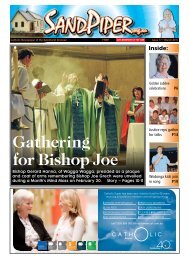Download this publication as PDF - Catholic Diocese of Sandhurst
Download this publication as PDF - Catholic Diocese of Sandhurst
Download this publication as PDF - Catholic Diocese of Sandhurst
Create successful ePaper yourself
Turn your PDF publications into a flip-book with our unique Google optimized e-Paper software.
April 2011 Adult Faith Education www.sandpiper.org.au – Page 13<br />
>> adult faith education<br />
Introducing the<br />
Gospel <strong>of</strong> St John<br />
In the final weeks <strong>of</strong> Lent, during Holy<br />
Week and through the E<strong>as</strong>ter se<strong>as</strong>on, we<br />
will listen to the Gospel <strong>of</strong> John, a rich<br />
source for prayer and reflection. This<br />
article forms the first in a short series<br />
focused on the fourth Gospel.<br />
The City <strong>of</strong> Ephesus<br />
In around 180CE, Saint Irenaeus<br />
<strong>of</strong> Lyon identified the<br />
apostle John, the son <strong>of</strong> Zebedee<br />
<strong>as</strong> author <strong>of</strong> the fourth Gospel<br />
and the letters <strong>of</strong> ‘John’; “John, the<br />
disciple <strong>of</strong> the Lord, who leaned<br />
on his bre<strong>as</strong>t, himself issued the<br />
Gospel while dwelling in Ephesus’<br />
where John lived “till the times <strong>of</strong><br />
Trajan’ (98 – 117 CE).<br />
Irenaeus’ information came from<br />
Polycarp, a personal friend <strong>of</strong> the<br />
apostle John, and others who had seen<br />
Jesus.<br />
Other early writers, including Justin<br />
Martyr and Polycrates who lived in<br />
Ephesus (in today’s Turkey), referred<br />
to a long residence <strong>of</strong> the apostle John<br />
in that town.<br />
Ephesus w<strong>as</strong> a multicultural port<br />
city. After Alexander the Great conquered<br />
the region around 333 BCE,<br />
Greek language w<strong>as</strong> used a great deal<br />
and Greek ide<strong>as</strong> were very influential.<br />
When the Romans took over, their systems<br />
<strong>of</strong> law and government became<br />
dominant. Architecture in Ephesus<br />
reflected Greek and Roman influences.<br />
The people came from diverse<br />
backgrounds, including Jewish people<br />
<strong>of</strong> the di<strong>as</strong>pora.<br />
The ‘di<strong>as</strong>pora’ refers to the growth<br />
<strong>of</strong> Jewish communities in many<br />
regions outside Palestine whose ancestors<br />
fled their homeland because <strong>of</strong><br />
persecution and troubles, especially<br />
due to foreign inv<strong>as</strong>ions, throughout<br />
the centuries.<br />
In the early days <strong>of</strong> the Christian<br />
mission, Jewish Christian leaders,<br />
including Paul, went first to teach the<br />
Jewish communities in each new town<br />
they visited.<br />
It w<strong>as</strong> Paul, together with married<br />
couple Priscilla (or Prisca) and Aquila,<br />
who founded the very first Christian<br />
community in Ephesus.<br />
The ‘Beloved Disciple’<br />
In time, a Christian community<br />
developed in Ephesus. Its<br />
leader appears to have been a<br />
Jew from Palestine, an eye witness<br />
to the life <strong>of</strong> Jesus. Revered <strong>as</strong> an<br />
ideal disciple, “the disciple whom<br />
Jesus loved”, appears at important<br />
moments in the Gospel, but is<br />
never named.<br />
The Gospel portrait <strong>of</strong> the ‘Beloved<br />
Disciple’ is therefore probably b<strong>as</strong>ed<br />
on a real historical person, known to<br />
the community, possibly their founder<br />
and leader.<br />
Whether <strong>this</strong> w<strong>as</strong> John the son <strong>of</strong><br />
Zebedee, one <strong>of</strong> the twelve, we do not<br />
know.<br />
A ‘Johannine’ community, faithful<br />
to the traditions handed down by a<br />
‘Beloved Disciple’, seems to have been<br />
responsible for the Gospel and letters<br />
<strong>of</strong> ‘John.’<br />
In John 21:24 the Gospel author is<br />
linked to <strong>this</strong> disciple.<br />
Many Scripture teachers believe<br />
‘the Beloved Disciple’ is an author in<br />
the sense <strong>of</strong> being the ‘mind’ behind<br />
the Gospel and letters <strong>of</strong> ‘John’.<br />
The ‘Beloved Disciple’ shared<br />
deep knowledge and insight regarding<br />
Jesus and the meaning <strong>of</strong> his life,<br />
death and resurrection.<br />
The Gospel and Letters <strong>of</strong> ‘John’<br />
contain similar language and ide<strong>as</strong><br />
but, with careful reading, different<br />
situations and time frames emerge.<br />
There is evidence these writings<br />
may have come from several writers,<br />
reshaping and editing the words<br />
through several stages and decades in<br />
the life <strong>of</strong> the community.<br />
One writer, the author <strong>of</strong> the third<br />
letter <strong>of</strong> John, is identified <strong>as</strong> an elder<br />
in the community.<br />
The letters are concerned with different<br />
ways <strong>of</strong> understanding Jesus,<br />
community divisions, problems concerning<br />
leadership and authority.<br />
Historical situation<br />
The fourth Gospel probably<br />
emerged near the end <strong>of</strong> the<br />
first century and the Letters<br />
soon after.<br />
A papyrus (the John Rylands<br />
papyrus) with a gospel fragment<br />
dated around 130 CE, indicates it w<strong>as</strong><br />
already circulating by <strong>this</strong> time.<br />
A Greek term, aposunagog<strong>as</strong>,<br />
meaning to be ‘put out <strong>of</strong> the synagogue’<br />
appears in the gospel.<br />
The term describes compulsory<br />
expulsion from synagogues, beginning<br />
with an edict in 85 CE, that<br />
forced synagogue members to pray<br />
that followers <strong>of</strong> Jesus <strong>of</strong> Nazareth<br />
would ‘perish’.<br />
Of course, faithful followers <strong>of</strong><br />
Jesus could not make <strong>this</strong> prayer their<br />
own!<br />
The earliest Christians were Jews,<br />
who continued to worship within<br />
Judaism, whilst embracing the teachings<br />
<strong>of</strong> Jesus.<br />
They recognised him <strong>as</strong> the Messiah,<br />
the fulfilment <strong>of</strong> all they believed<br />
<strong>as</strong> Jewish people.<br />
The edict <strong>of</strong> 85 AD caused loss,<br />
grief and a total split from the practice<br />
<strong>of</strong> Judaism for Jesus’ followers. With<br />
<strong>this</strong> went the breakdown <strong>of</strong> connections<br />
with family and friends.<br />
The fourth Gospel reflects <strong>this</strong><br />
experience (see John Chapter 9). The<br />
Gospel w<strong>as</strong> composed some time after<br />
the events <strong>of</strong> 85 CE.<br />
Community<br />
Early Gospel readers were<br />
Greek speaking Christians<br />
<strong>of</strong> Jewish and Gentile (non<br />
Jewish) background. The Pax<br />
Romana, or ‘Roman Peace’ that<br />
had allowed tolerance <strong>of</strong> local religious<br />
groups w<strong>as</strong> breaking down.<br />
After 85 CE, Jewish Christians<br />
suffered a break with the faith <strong>of</strong><br />
their ancestors.<br />
Both Gentile and Jewish Christians<br />
were persecuted by Roman colonial<br />
powers. Denunciation to the Romans<br />
had resulted in death for some.<br />
Challenges and crises beset the<br />
Johannine community from outside<br />
and inside.<br />
They felt the world w<strong>as</strong> opposed to<br />
them. The Gospel refers <strong>of</strong>ten to difficulties<br />
faced by Jesus’ disciples in the<br />
‘world’. Yet God sent Jesus out <strong>of</strong> love<br />
for the world (John 1:9-10; 3:16)!<br />
At the time <strong>this</strong> Gospel developed,<br />
there were people claiming to belong<br />
to select groups with the secret knowledge<br />
(gnosis) required for salvation by<br />
a mysterious redeemer.<br />
A ‘Gnostic’ redeemer would come<br />
from the heavens to take back a chosen<br />
few.<br />
The fourth gospel rejects Gnostic<br />
teachings. Jesus and his message are<br />
for everyone.<br />
Discipleship<br />
The Gospel seeks to<br />
strengthen Jesus’ disciples<br />
in difficult times. It also<br />
h<strong>as</strong> a universal message for new<br />
believers and for the whole world.<br />
It is written so that people might<br />
come to faith in Jesus and so have<br />
life in his name (Jn 20:31).<br />
Readers, like characters in the<br />
story, must decide how they are going<br />
to respond to Jesus Christ. Each is<br />
invited to a relationship <strong>of</strong> complete<br />
faith and trust in Jesus.<br />
For Jewish Christians, whose synagogue<br />
ties were broken, the Gospel<br />
presents Jesus <strong>as</strong> the One who fulfils<br />
Ephesus <strong>as</strong> seen by <strong>Sandhurst</strong> <strong>Diocese</strong> pilgrims in 2007.<br />
the purpose and meaning <strong>of</strong> all the The ‘disciple whom Jesus<br />
Jewish fe<strong>as</strong>ts, including P<strong>as</strong>sover, loves’ (chapters 13, 19, 20 &<br />
which is giving new meaning (Jn 6;<br />
13-21).<br />
21), becomes the true ideal<br />
Personal journeys <strong>of</strong> faith, from <strong>of</strong> discipleship, in contr<strong>as</strong>t with the<br />
incomplete to complete faith in Jesus, failures <strong>of</strong> both Peter and Jud<strong>as</strong>.<br />
are a focus <strong>of</strong> the first twelve chapters. This beloved one remains close to<br />
In the final chapters (Jn 13-21),<br />
Jesus. He is ready to follow Jesus in<br />
self giving love is a major focus (Jn<br />
15:12-14).<br />
loving ‘to the end’ (13:1 and 15:12-14).<br />
Jesus’ death appears to be the hour The Beloved Disciple shows love<br />
<strong>of</strong> loss and failure. Yet <strong>this</strong> is the hour h<strong>as</strong> primacy in the life <strong>of</strong> a disciple.<br />
when Jesus’ life <strong>of</strong> self giving, serving Through <strong>this</strong> Gospel, and the letters <strong>of</strong><br />
love reaches fulfilment. It is the hour<br />
‘John’, we know that we are all called<br />
<strong>of</strong> his glory.<br />
He loved ‘to the end’ (Jn 13:2)<br />
<strong>as</strong> ‘Beloved Disciples’.<br />
and <strong>this</strong> reality is there for all to see Jesus’ disciples are his friends,<br />
(Jn 19:37). The God <strong>of</strong> love h<strong>as</strong> been commanded to serve and to love one<br />
revealed in Jesus. Later, 1 John 4:7 another (13:1-16; 13:34-35; 15:12-14),<br />
will state ‘God is Love.”<br />
even to the greatest love <strong>of</strong> laying<br />
Jesus’ disciples are sent to continue<br />
down <strong>of</strong> life for others, <strong>as</strong> he h<strong>as</strong> done.<br />
<strong>as</strong> he h<strong>as</strong> begun;<br />
“If I, your Lord and Teacher have Disciples are not perfect people in <strong>this</strong><br />
w<strong>as</strong>hed your feet,<br />
Gospel.<br />
you also ought to w<strong>as</strong>h one another’s<br />
feet...” (Jn 13:14)<br />
community <strong>as</strong> it is among Christians<br />
This w<strong>as</strong> <strong>as</strong> true <strong>of</strong> the Johannine<br />
“Love one another <strong>as</strong> I have loved<br />
today.<br />
you...No one h<strong>as</strong> greater love than <strong>this</strong>,<br />
to lay down one’s life for one’s<br />
Disciples are chosen and called<br />
friends” (Jn 15:12-14)<br />
by Jesus, although he knows very<br />
‘’Peace be with you. As the Father well that they (and we) may fail. The<br />
sent me, so I am sending you. important thing is to stay in a relationship<br />
<strong>of</strong> faith and trust, love and<br />
Receive the Holy Spirit…..’ (John<br />
20:21).<br />
closeness to Jesus.<br />
The Beloved Disciple and all This is the stance <strong>of</strong> the Beloved<br />
Disciples<br />
Disciple.
















